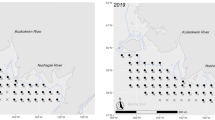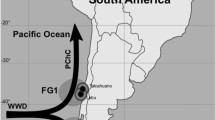Abstract
The trophic ecology of the small yellow croaker (Larimichthys polyactis) was studied using stable isotope analyses. Samples were collected from July to September 2009 and 34 individuals from eight sites were examined for stable carbon and nitrogen isotopes. Stable carbon isotope ratios (δ 13C) ranged from −20.67 to −15.43, while stable nitrogen isotope ratios (δ 15N) ranged 9.18–12.23. The relationship between δ 13C and δ 15N suggested high resource partitioning in the sampling area. Significant differences in stable isotope values among the eight sampling sites may be linked to environmental diversities involving various physical processes (such as ocean current, wind and tide) and different carbon sources. Furthermore, the stable isotope ratios may also explain the ontogenetic variability in diet and feeding, because δ 13C and δ 15N varied significantly with increasing body size. The findings are consistent with other studies on diet analyses in small yellow croaker. It was also demonstrated that stable isotope analysis could be used to estimate the trophic characters of small yellow croaker in feeding patterns and migrating habits.
Similar content being viewed by others
Refernces
Bray T R, Curtis J T. 1957. An ordination of the upland forest communities of southern Wisconsin. Ecol. Monogr., 27: 325–349.
Brodeur R D, Pearcy W G. 1992. Effects of environmental variability on trophic interactions and food web structure in a pelagic upwelling ecosystem. Mar. Ecol. Prog. Ser., 84: 101–119.
Cabana G, Rasmussen J. 1994. Modelling food-chain structure and contaminant bioaccumulation using stable nitrogen isotopes. Nature, 372: 255–257.
Carr W E S, Adams C A. 1973. Food habits of juvenile marine fishes occupying seagrass beds in the estuarine zone near Crystal River, Florida. Trans. Am. Fish. Soc., 102: 511–540.
Cheng J H, Cheung W W L, Pitcher T J. 2009. Mass-balance ecosystem model of the East China Sea. Prog. Nat. Sci., 19: 1 271–1 280.
Clarke K R, Gorley R N. 2006. PRIMER v6: User Manual/Tutorial. PRIMER-E, Plymouth, UK.
Currin C A, Wainright S C, Able K W, Weinstein M P, Fuller C M. 2003. Determination of food web support and trophic position of the mummichog, Fundulus heteroclitus in New Jersey smooth cordgrass (Spartina alterniflora), common reed (Phragmites australis), and restored salt marshes. Estuaries, 26: 495–510.
DeNiro M J, Epstein S. 1978. Influence of diet on the distribution of carbon isotope in animals. Geochim. Cosmochim. Acta, 42: 495–506.
France R L. 1996. Absence or masking of metabolic fractionations of 13C in a freshwater benthic food web. Freshwater Biol., 36: 1–6.
Guiguer K R R A, Reist J D, Power M, Babaluk J A. 2002. Using stable isotopes to confirm the trophic ecology of Arctic charr morphotypes from Lake Hazen, Nunavut, Canada. J. Fish. Biol., 60: 348–362.
Jacob U, Mintenbeck K, Brey T, Knust R, Beyer K. 2005. Stable isotope food web studies: a case for standardized sample treatment. Mar. Ecol. Prog. Ser., 287: 251–253.
Jennings S, Pinnegar J K, Polunin N V C, Warr K J. 2002. Linking size-based and trophic analyses of benthic community structure. Mar. Ecol. Prog. Ser., 226: 77–85.
Jiang Y Z, Cheng J H, Li S F. 2009. Temporal changes in the fish community resulting from a summer fishing moratorium in the northern East China Sea. Mar. Ecol. Prog. Ser., 387: 265–273.
Laughlin R. 1982. Feeding habits of the blue crab, Callinectes sapidus Rathbun, in the Apalachicola estuary, Florida. Bull. Mar. Sci., 32: 807–822.
Lin L S. 2007. Study on feeding habit and trophic level of redlip croaker in Changjiang estuary. Mar. Fish., 29: 44–48. (in Chinese with English abstract)
Lin L S. 2009. Study on Fishery Biology and Management Strategy of Larimichthys Polyactis in the Southern Yellow Sea and the East China Sea. Ph. D. Thesis. Ocean University of China, Qingdao, China. (in Chinese with English abstract)
Madurell T, Fanelli E, Cartes J E. 2008. Isotopic composition of carbon and nitrogen of suprabenthic fauna in the NW Balearic Islands (western Mediterranean). J. Mar. Syst., 71: 336–345.
Matthews B, Mazumder A. 2005. Temporal variation in body composition (C:N) helps explain seasonal patterns of zooplankton δ 13C. Freshwater Biol., 50: 502–515.
Minagawa M, Wada E. 1984. Stepwise enrichment of 15N along food chains: further evidence and the relation between δ 15N and animal age. Geochim. Cosmochim. Acta, 48: 1 135–1 140.
Owens N J P. 1987. Natural variations in 15N in the marine environment. Adv. Mar. Biol., 24: 389–451.
Pomeroy L R, Wiebe W J, Deibel D, Thompson R J, Rowe G T, Pakulski J D. 1991. Bacterial responses to temperature and substrate concentration during the Newfoundland spring bloom. Mar. Ecol. Prog. Ser., 75: 143–159.
Post D M. 2002. Using stable isotopes to estimate trophic position: models, methods, and assumptions. Ecology, 83: 703–718.
Rau G H. 1980. Carbon-13/Carbon-12 variation in subalpine lake aquatic insects: food source implications. Can. J. Fish. Aquat. Sci., 37: 742–746.
Renones O, Polunin N V C, Goni R. 2002. Size related dietary shifts of Epinephelus marginatus in a western Mediterranean littoral ecosystem: an isotope and stomach content analysis. J. Fish Biol., 61: 122–137.
Rooker J R, Turner J P, Holt S A. 2006. Trophic ecology of Sargassum associated fished in the Gulf of Mexico determined from stable isotopes and fatty acids. Mar. Ecol. Prog. Ser., 313: 249–259.
Romanuk T N, Levings C D. 2005. Stable isotope analysis of trophic position and terrestrial vs. marine carbon sources for juvenile Pacific salmonids in nearshore marine habitats. Fish. Manag. Ecol., 12: 113–121.
Satterfield IV F R, Finney B P. 2002. Stable isotope analysis of Pacific salmon: insight into trophic status and oceanographic conditions over the last 30 years. Prog. Oceanogr., 53: 231–246.
Sheridan P. 1979. Trophic resource utilization by three species of Sciaenid fishes in a Northwest Florida estuary. Northeast Gulf Sci., 3: 1–15.
Sherwood G D, Rose G A. 2005. Stable isotope analysis of some representative fish and invertebrate of the Newfoundland and Labrador continental shelf food web. Estuar. Coast. Shelf Sci., 63: 537–539.
Tieszen L L, Boutton T W, Tesdahl K G, Slade N H. 1983. Fractionation and turnover of stable carbon isotopes in animal tissues: implications for 13C analysis of diet. Oecologia, 57: 32–37.
Vander Zanden M J, Rasmussen J B. 2001. Variation in δ 15N and δ 13C trophic fractionation: implications for aquatic food web studies. Limnol. Oceanogr., 46: 2 061–2 066.
Wada E, Terazaki M, Kabaya Y, Nemoto T. 1987. 15N and 13C abundances in the Antarctic Ocean with emphasis on the biogeochemical structure of the food web. Deep-Sea Res., 34: 829–841.
Wilson R M, Chanton J, Lewis G, Nowacek D. 2009. Isotopic variation (δ 15N, δ 13C, and δ 34S) with body size in post-larval estuarine consumers. Estuar. Coast. Shelf Sci., 83: 307–312.
Wootton R J. 1990. Ecology of Teleost Fishes. Chapman and Hall Press, London.
Xue Y, Jin X, Zhang B, Liang Z. 2005. Seasonal, diel and ontogenetic variation in feeding patterns of small yellow croaker in the central Yellow Sea. J. Fish Biol., 67: 33–50.
Yan L P, Li J S, Shen D G, Yu L F, Ling L Y. 2006. Variations in diet composition and feeding intensity of small yellow croaker Larimichthys polyactis Bleeker in the southern Yellow Sea and northern East China Sea. Mar. Fish., 27: 117–123. (in Chinese with English abstract)
Yin M C. 1995. Ecology of Fish. Agriculture Press, Beijing, China. (in Chinese)
Zhuang P, Wang Y H, Li S F, Deng S M, Li C S, Ni Y. 2006. Fishes of the Yangtze Estuary. Shanghai Scientific and Technical Publishers Press, Shanghai, China. (in Chinese)
Author information
Authors and Affiliations
Corresponding author
Additional information
Supported by the Special Research Fund for the National Non-profit in East China Sea Fisheries Research Institute (No. 2009M01)
Rights and permissions
About this article
Cite this article
Ji, W., Chen, X., Jiang, Y. et al. Trophic ecology of small yellow croaker (Larimichthys polyactis Bleeker): stable carbon and nitrogen isotope evidence. Chin. J. Ocean. Limnol. 29, 1033–1040 (2011). https://doi.org/10.1007/s00343-011-0188-2
Received:
Accepted:
Published:
Issue Date:
DOI: https://doi.org/10.1007/s00343-011-0188-2




